When selecting the best hiking boots for fell walking, consider durable oiled nubuck or full-grain leather options for longevity, such as the Scarpa Rush Trk Pro GTX. Waterproofing is essential; Gore-Tex membranes in models like Meindl Bhutan MFS offer superior water resistance. Look for boots with advanced traction technologies such as Vibram soles, ideal for scrambling or uneven terrains, found in La Sportiva TX5 GTX. Ankle support and breathability, vital for comfort, are well-addressed in options like the Scarpa Boots. Various weight classes and eco-friendly designs enhance performance and sustainability, providing compelling choices for diverse hiking needs. Discover detailed evaluations and expert recommendations within the guide.
Key Takeaways
- Scarpa Rush Trk Pro GTX offers durability with oiled nubuck leather, ideal for fell walking.
- Meindl Bhutan MFS features a Gore-Tex liner, ensuring waterproofing in wet conditions.
- La Sportiva TX5 GTX is designed for scrambling, featuring a Vibram sole for traction.
- Proper fit and sizing ensure optimal comfort and performance on diverse terrains.
- Lightweight construction and advanced materials like EVA midsoles reduce fatigue during hikes.
Top Picks for Fell Walking
Starting on the rugged landscapes of fell walking demands footwear that balances durability, comfort, and performance; consequently, the Scarpa Rush Trk Pro GTX emerges as a standout choice. Priced at £230, this boot brand is known for its robust construction, featuring oiled nubuck leather that withstands harsh terrains.
The generous ankle padding and underfoot cushioning make it suitable for three-season use, offering excellent support and comfort across varied landscapes. Scarpa's design considerations emphasize resilience and comfort, making it ideal for those who frequently engage in fell walking.
Other notable boot brands include the Meindl Bhutan MFS and the La Sportiva TX5 GTX. The Meindl Bhutan, priced at £275, is revered for its durability and innovative Gore-Tex liner, which provides waterproofing essential for unpredictable fell conditions.
Its design guarantees stability and support during extended hikes, catering to diverse terrain considerations. Meanwhile, the La Sportiva TX5 GTX, intended for scrambling, utilizes a Vibram sole and Gore-Tex lining to deliver exceptional grip and protection on rugged surfaces.
Priced at approximately £200, it offers a strategic blend of lightweight flexibility and robust defense, catering to specific fell walking needs.
Essential Features of Hiking Boots
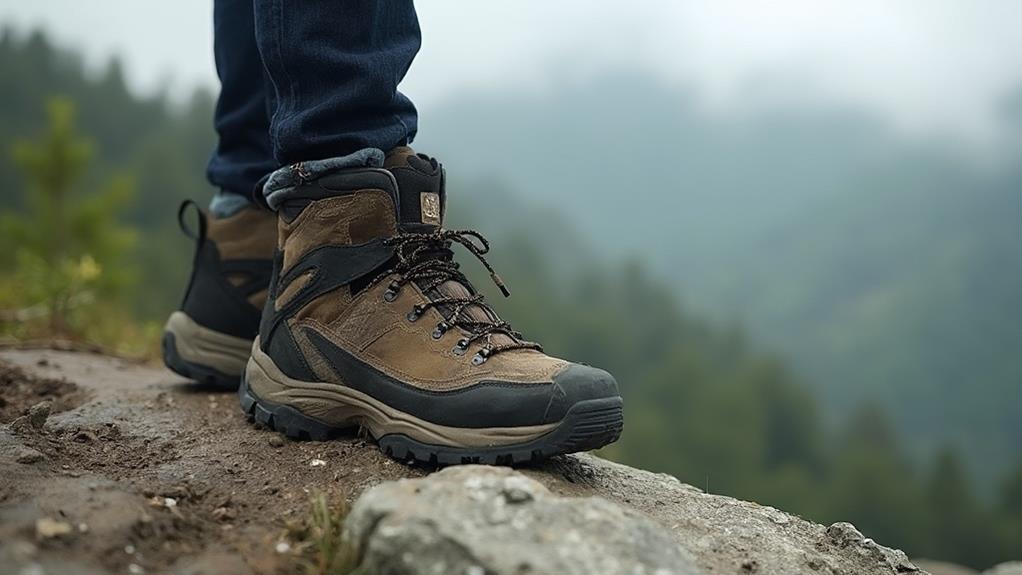
Having reviewed top picks for fell walking, understanding the core attributes that define ideal hiking boots is vital. The essential features revolve around innovations in hiking boot technology, emphasizing support, waterproofing, breathability, weight, and traction.
An ergonomic design is significant, with mid or high-top configurations providing the necessary ankle support to mitigate injury risk on uneven terrains. Brands like Salomon and Merrell have excelled in integrating supportive structures without compromising flexibility.
Waterproofing is another indispensable feature. Gore-Tex membranes remain the industry standard, ensuring feet stay dry in wet conditions typical of fell walking. This technology has been adopted by leading brands such as Scarpa and La Sportiva, offering reliable protection without sacrificing breathability.
Breathability complements waterproofing by maintaining a comfortable microclimate inside the boot. Ventilated uppers, often using mesh or moisture-wicking liners, are incorporated in designs by innovators like Columbia, balancing moisture control and temperature regulation.
Weight considerations are vital, as lightweight boots reduce fatigue over extended distances. Advanced materials like EVA midsoles contribute to reduced weight while maintaining cushioning.
Testing and Evaluation Process
Thoroughness defines the testing and evaluation process for hiking boots, guaranteeing that each pair is subjected to rigorous scrutiny. Conducted over three months in South Downs National Park, the process meticulously assessed 145 unique pairs of boots across a variety of terrains.
This diverse terrain adaptability testing gauged grip, comfort, waterproofing, and support, essential for fell walking. Boots were subjected to both winter and summer conditions, providing insights into their seasonal performance. This guaranteed that recommendations account for the boots' ability to withstand and perform under diverse weather conditions.
Focus was placed on key metrics such as weight, durability, and fit. The evaluation aimed to derive boots that not only meet but exceed the specific demands of fell walking.
This was complemented by expert insights and extensive user feedback, facilitating a thorough understanding of each model's strengths and potential limitations. The process was designed to guarantee that the boots selected provide prime support and reliability for various hiking scenarios.
The integration of these rigorous evaluation methodologies guarantees that only the most adaptable and high-performing boots are recommended, aligning with the demands of serious hikers and outdoor enthusiasts.
Best Men's Hiking Boots
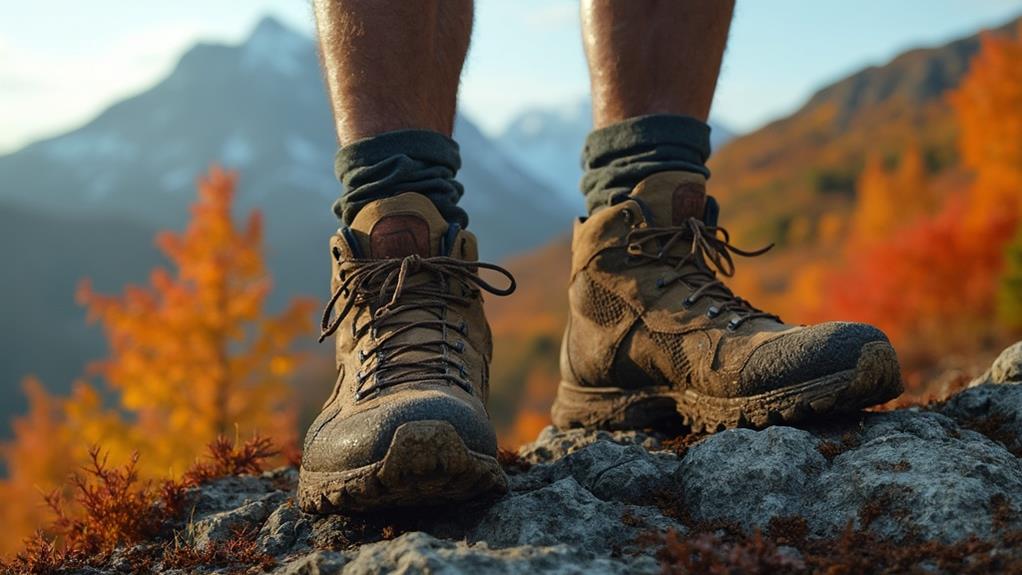
When selecting the best men's hiking boots for fell walking, precision in design and functionality is paramount. Among the top contenders is the Hoka Kaha 2, renowned for its unparalleled grip on icy surfaces, weighing a mere 518g. This model exemplifies the pinnacle of men's boot styles, integrating cutting-edge hiking boot materials to guarantee durability and performance in challenging terrains.
The Salomon Quest 4 GTX stands out with its stability-focused construction and aggressive outsole, designed for technical trails. Weighing in at 2 lb. 14.2 oz., it offers excellent cushioning, enhancing comfort on prolonged hikes.
Meanwhile, the Scarpa Terra II GTX, at just 210g, offers a lightweight alternative with a quick lacing system, perfect for relaxed walking on uneven terrain.
Keen Targhee III is highly rated for its flexibility and comfort, making it an ideal companion for summer hikes. At 490g, it balances lightweight construction with robust performance, making it a versatile choice for fell walking.
The Meindl Peru, though heavier at 680g, excels in waterproofing and ankle support, tailored for more demanding conditions. Each of these boots showcases unique attributes, catering to varied preferences and requirements in men's boot styles and materials.
Best Women's Hiking Boots
In evaluating the best women's hiking boots for fell walking, it is essential to take into account top contenders such as the Meindl Respond Lady Mid, Columbia Facet 75 Mid Outdry, and Keen Targhee IV, each offering distinct advantages regarding weight, waterproofing, and ergonomic support.
Key features to prioritize include advanced outsole technologies like Adapt Trax and KEEN.FUSION, which enhance traction and stability across varied terrains.
Additionally, the integration of eco-friendly materials and innovative sole designs, as seen in models like the Hoka One One Sky To Sea and Scarpa Rush Trek Lite GTX, underscores the importance of sustainable and comfortable hiking solutions for all-day excursions.
Top Women's Boot Models
Although the market is saturated with numerous options, selecting the best women's hiking boots requires an informed assessment of technical features and brand reliability. A comparative analysis of boot fit and brand offerings is essential for optimizing both comfort and performance on the trails.
Among the top contenders, the Meindl Respond Lady Mid Walking Boots stand out with a lightweight design (360g) and Gore-Tex technology, ensuring waterproof excellence and grip across diverse terrains. Priced at £185, they exemplify high-quality craftsmanship.
Considering brand comparisons, the Columbia Facet 75 Mid Outdry Waterproof Hiking Shoe offers a competitive edge at £135. Weighing 400g, its Adapt Trax outsole enhances both comfort and traction, making it a versatile choice for varied hiking conditions.
Meanwhile, the Keen Targhee IV Waterproof Hiking Boot, priced at £136.95, caters to those requiring a wider fit and integrates KEEN.FUSION technology for eco-friendly comfort.
Discover the Best Features:
- Meindl Respond Lady – Lightweight, waterproof, and high-grip.
- Columbia Facet 75 Mid – Affordable, adaptable, and comfort-focused.
- Keen Targhee IV – Wide fit, eco-friendly, and technologically advanced.
These models epitomize the blend of innovative design and reliable performance.
Key Features to Consider
Selecting the best women's hiking boots for fell walking necessitates a thorough understanding of key features that impact performance and comfort. Essential considerations include lightweight construction, waterproofing, and innovative boot technology. For instance, the Meindl Respond Lady Mid, weighing 360g, employs a Gore-Tex upper, guaranteeing optimal waterproofing—crucial for maintaining hiking performance in wet conditions. Meanwhile, the Columbia Facet 75 Mid Outdry combines a 400g supportive structure with Adapt Trax outsole technology, enhancing grip on challenging terrains.
| Feature | Example Model |
|---|---|
| Lightweight | Meindl Respond Lady Mid (360g) |
| Waterproofing | Columbia Facet 75 Mid Outdry |
| Ankle Support | Scarpa Boreas GTX Mid |
Ankle support is essential; the Scarpa Boreas GTX Mid features a high boot cuff, providing stability on uneven ground. Breathability is another crucial aspect, with models like the Keen Targhee III offering flexibility and moisture management, enhancing comfort during summer hikes. Finally, prioritize fit and comfort, as seen in the Hoka Kaha 2, available in regular and wide widths. This guarantees optimal adaptation to diverse foot shapes, enhancing overall hiking performance. By focusing on these features, one can select boots that excel in diverse fell walking scenarios.
Waterproofing and Breathability
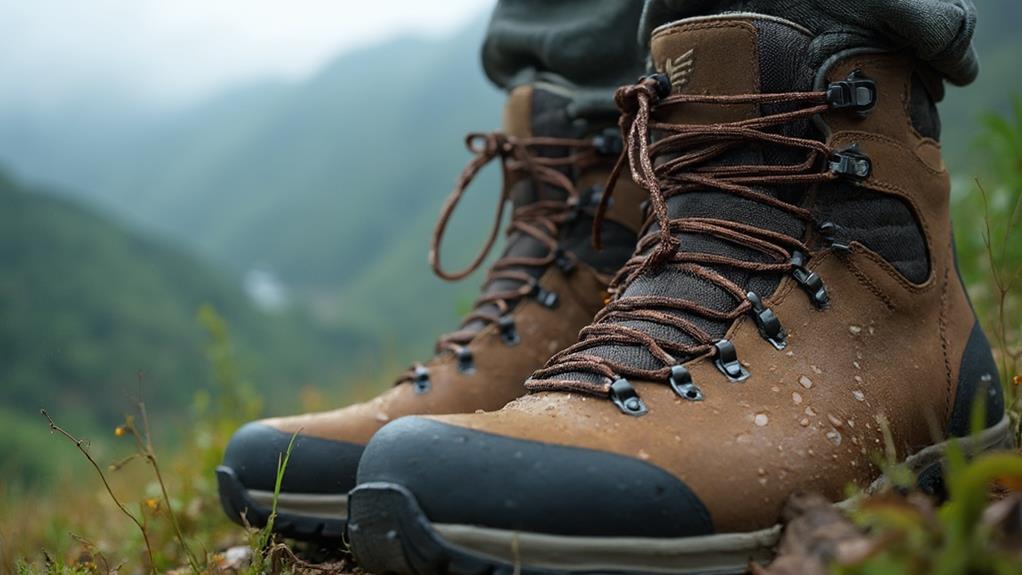
In the domain of hiking boots, the integration of Gore-Tex membranes stands paramount for optimizing waterproofing while maintaining breathability, a dual advantage that is indispensable for fell walking.
Effective moisture management techniques, such as utilizing hydrophobic materials and strategically placed ventilation, guarantee that perspiration is efficiently wicked away, reducing the potential for discomfort and blisters.
Moreover, the selection of breathable materials, such as advanced synthetics, offers a harmonious balance between protection from external elements and internal climate control, catering to the rigorous demands of outdoor enthusiasts.
Gore-Tex Membrane Benefits
Among the numerous advancements in outdoor footwear technology, the Gore-Tex membrane stands out as a significant innovation, particularly regarding waterproofing and breathability. The Gore-Tex advantages are manifold, beginning with its unrivaled waterproofing capabilities. With a waterproof rating of at least 28,000 mm, the Gore-Tex membrane guarantees that water is effectively repelled, making it indispensable for traversing wet conditions and stream crossings.
Simultaneously, it facilitates moisture vaporization, allowing perspiration to escape due to its impressive Moisture Vapor Transmission Rate (MVTR) exceeding 20,000 g/m²/24h. This dual functionality maintains an ideal foot climate, essential for comfort during prolonged hiking sessions.
The impact of Gore-Tex on hiking boot performance is profound, offering a blend of protection and comfort. Consider these benefits:
- Stay Dry, Stay Comfortable: Experience the assurance of dry feet, even in torrential downpours.
- Breathability Beyond Compare: Enjoy continuous airflow that keeps moisture at bay, enhancing hiking performance.
- Durability for the Long Haul: Benefit from a resilient design that withstands abrasion and punctures, extending footwear longevity.
Moreover, many Gore-Tex equipped boots incorporate additional insulation, adeptly balancing warmth and breathability, making them suitable for diverse weather conditions.
Moisture Management Techniques
An effective moisture management strategy in hiking boots hinges on the synergy between waterproofing and breathability technologies. Leading the charge in waterproofing, Gore-Tex membranes function as a robust barrier, preventing external moisture from infiltrating while allowing perspiration to escape. This dual-action capability guarantees that feet remain dry and comfortable, optimizing temperature regulation during long treks.
The integration of such membranes exemplifies advanced moisture management, essential for maintaining foot health in unpredictable weather conditions.
Breathability complements waterproofing by facilitating airflow through strategically designed materials, which helps regulate temperature and prevent overheating. This feature becomes particularly significant during strenuous fell walking activities. Many contemporary hiking boots, such as those from brands like Salomon and Merrell, incorporate a blend of waterproof and breathable elements, offering thorough protection against the elements.
The design of hiking boots also plays a key role in moisture management. Mid and high-top designs can effectively keep out debris and water, while simultaneously providing important ankle support.
To maintain the effectiveness of these technologies, regular maintenance, including cleaning and applying appropriate waterproofing treatments, is critical. This guarantees that the boots' moisture management and temperature regulation capabilities remain at their peak performance, prolonging their lifespan.
Breathable Material Advantages
Building upon the foundation of moisture management techniques, the utilization of breathable materials in hiking boots highlights a sophisticated approach to both waterproofing and breathability.
Breathable innovations, such as Gore-Tex, exemplify the pinnacle of moisture control by allowing perspiration to escape without permitting external water entry. This dual capability guarantees that hikers' feet remain dry and comfortable even during prolonged fell walking adventures.
By incorporating a combination of breathable mesh and waterproof membranes, modern hiking boots achieve an ideal balance between protection and ventilation, catering effectively to varied weather conditions.
The advantages of breathable materials extend beyond mere comfort. Enhanced breathability mitigates the risks associated with sweat accumulation, such as blisters and discomfort, which are critical concerns during long-duration hikes.
Additionally, high-quality breathable materials play an essential role in maintaining overall foot health by reducing moisture buildup, thereby preventing fungal infections and foot odor over time.
The integration of these materials not only guarantees waterproofing but also contributes to a lighter boot construction, enhancing agility and comfort across challenging terrains.
Consider these compelling benefits:
- Improved foot health: Minimized moisture reduces infection risk.
- Enhanced comfort: Reduced sweat accumulation prevents blisters.
- Agility boost: Lightweight design for challenging terrains.
Support and Comfort
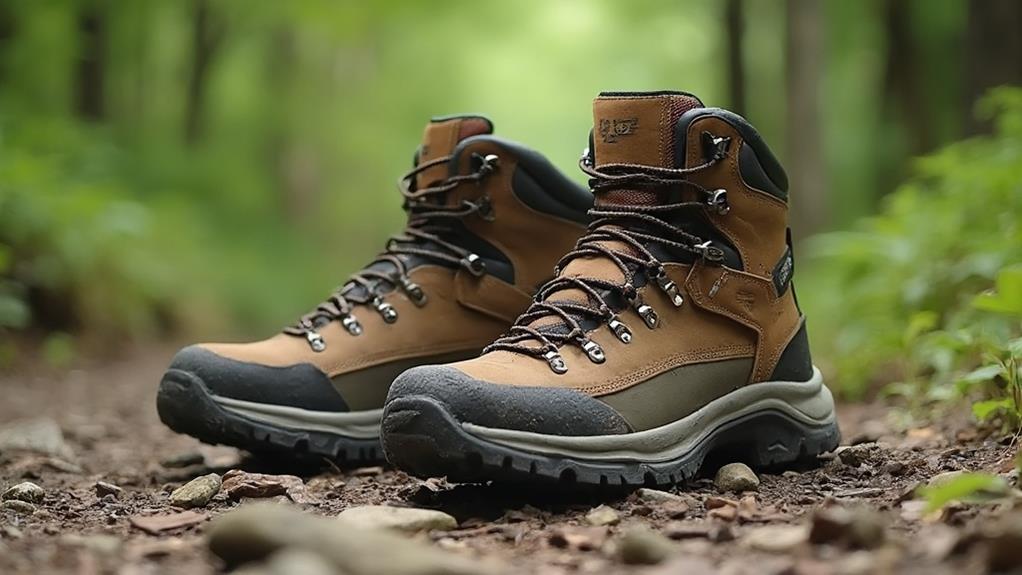
When venturing into the rugged landscapes of fell walking, the significance of selecting hiking boots with ideal support and comfort cannot be overstated. Ankle stability is paramount, as uneven terrain exerts considerable strain on the ankles and feet. The Meindl Bhutan MFS is exemplary, with its high boot cuff offering substantial ankle stabilization, mitigating the risk of sprains on rocky paths.
Similarly, the Scarpa R-Evolution GTX is engineered to provide robust support on technical trails, ensuring that hikers remain steady and secure.
Cushioning technology is equally vital in achieving optimal comfort during prolonged hikes. The Hoka Kaha 2 is renowned for its thick EVA midsole, delivering unparalleled cushioning that absorbs shock efficiently on varied terrains. This cushioning is essential not only for comfort but also for minimizing fatigue over extended distances.
Additionally, the Merrell Moab 3 emphasizes the importance of fit, advocating for a thumbs-width space between the big toe and the boot's front, accommodating natural foot movement on descents.
Weight is another pivotal factor influencing comfort. The lightweight design of the Salomon X Ultra 4 Mid GTX reduces fatigue without compromising support, making it an excellent choice for fell walking enthusiasts.
Grip and Traction
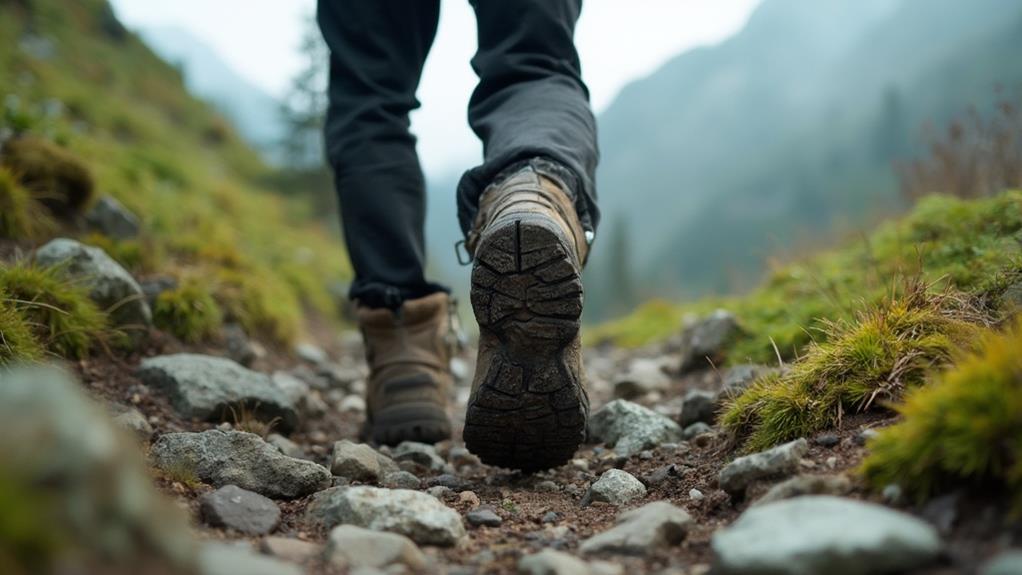
Grip and traction are fundamental attributes for hiking boots designed for fell walking, given the unpredictable and often treacherous nature of these terrains. The lugs design plays a crucial role in providing the necessary stability.
Boots like the Salomon Quest 4 GTX are equipped with aggressive lugs that guarantee excellent traction on wet and rocky surfaces, essential during unexpected weather changes. Similarly, the Scarpa Zodiac Plus GTX showcases deep, multidirectional lugs, enhancing grip on steep slopes and loose gravel.
Outsole materials are equally crucial in determining a boot's effectiveness in gripping varied surfaces. Innovative rubber compounds, such as those infused with graphene found in the Inov-8 RocFly G 390 GTX, greatly improve grip performance on both wet and dry terrains.
These materials are particularly advantageous for maintaining traction without compromising flexibility and sensitivity.
Consider the following when choosing your ideal hiking boot:
- Confidence on Inclines: Boots with multidirectional lugs provide the assurance needed on steep, unpredictable inclines.
- Weather Versatility: Graphene-infused rubber guarantees grip in varying weather conditions.
- Stability in Motion: Proper fit minimizes heel movement, maximizing ground contact and enhancing stability.
Investing in the right combination of lugs design and outsole materials is crucial for a successful fell walking experience.
Weight and Durability
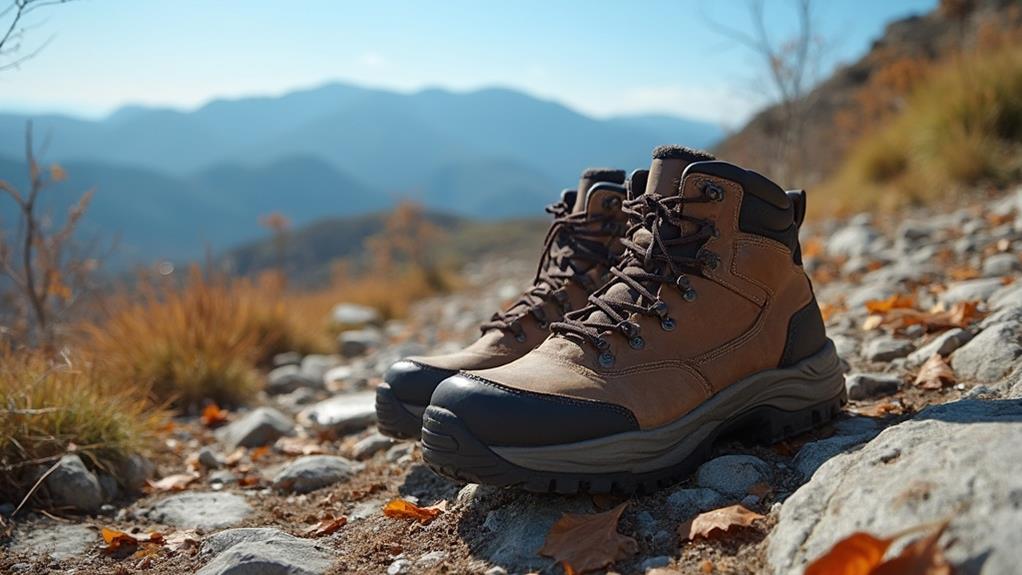
When considering the ideal balance between weight and durability in hiking boots, the Altra Lone Peak Hiker 2 exemplifies how lightweight materials can enhance comfort and reduce fatigue over extended treks.
Conversely, models like the Meindl Bhutan, with their robust leather construction and Gore-Tex lining, underscore the importance of durability for year-round performance in challenging conditions.
The integration of high-quality materials, such as Gore-Tex membranes, not only guarantees waterproofing but also fortifies the boots against diverse weather, thereby extending their lifespan with proper maintenance.
Lightweight Material Benefits
In the domain of modern hiking footwear, many have turned to lightweight materials such as synthetic fabrics and engineered mesh to optimize performance and comfort.
These lightweight innovations are pivotal for performance optimization, particularly in the challenging terrains of fell walking. By reducing overall boot weight, these materials facilitate quicker movement and reduce fatigue on prolonged hikes. This reduction in mass is achieved without compromising on essential features such as waterproofing, thanks to advanced composites like Gore-Tex.
These composites provide a durable, water-resistant barrier akin to traditional materials but without the associated bulk.
- Enhanced Agility: The adoption of lightweight materials results in improved agility on the trail, allowing hikers to navigate complex terrains with ease and precision.
- Superior Comfort: Specialized cushioning systems integrated into lightweight boots guarantee that comfort is not sacrificed for weight. These systems maintain a lower weight profile while providing the necessary support for arduous journeys.
- Rapid Drying: Boots crafted from these materials dry faster post-exposure to moisture, essential for maintaining comfort in variable weather conditions.
These advancements underscore the paradigm shift towards lightweight materials, marking a significant evolution in hiking boot design.
Durability Enhancements
Durability in hiking boots is a significant factor, especially in the demanding environment of fell walking, where rugged terrains put footwear to the test. Material choices and boot construction play pivotal roles in enhancing durability. Heavier boots, typically weighing over 2.5 lbs, are often crafted from robust materials like full-grain leather, which offers superior longevity, often outlasting synthetic counterparts by years. Stiffness ratings further contribute to durability assessments; boots rated B2 to B3 provide essential support and are less prone to damage on technical trails.
| Weight (lbs) | Material | Durability Rating |
|---|---|---|
| 1.5 – 2.5 | Synthetic | Moderate |
| Over 2.5 | Full-Grain Leather | High |
| 1.5 – 2.5 | Leather/Synthetic Mix | Moderate |
| Over 2.5 | Synthetic | Moderate |
The inclusion of high-quality rubber outsoles, such as those from Vibram and Contagrip, enhances both traction and durability. These outsoles are engineered for excellent wear resistance, important for the rocky terrain of fells. Proper boot care, including regular cleaning and conditioning, can further extend the lifespan of these hiking boots by 30% or more, preserving their structural integrity and performance. Understanding these elements is essential for selecting boots that will withstand the challenges of fell walking.
Fit and Sizing Tips
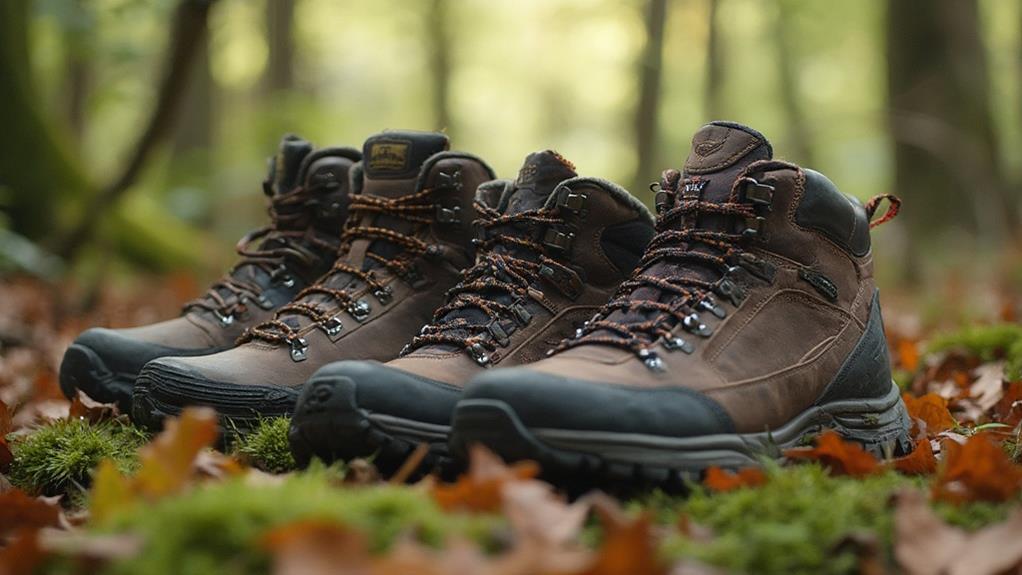
Although often overlooked, the proper fit and sizing of hiking boots are vital for a successful fell walking experience, guaranteeing both comfort and performance. Selecting boots that match your foot shape is critical, as many brands offer sizing variations, including standard and wide options. This guarantees that the boots conform to your unique dimensions, preventing discomfort and enhancing mobility.
When trying on hiking boots, adhere to specific guidelines to optimize fit and performance.
- Toe Room: Confirm there is approximately a thumb's width of space between your longest toe and the boot's front. This allowance accommodates foot movement, especially when descending, reducing the risk of bruising or blisters.
- Sock Compatibility: Wear the socks intended for hiking during fitting sessions. Sock thickness greatly impacts the boot's fit, and using the correct ones can prevent unexpected tightness or looseness during actual hikes.
- Heel Fit: Opt for a snug fit around the heel to mitigate slippage—a common precursor to blisters on extended treks.
Testing boots on an incline is paramount, simulating the dynamic conditions of fell walking. This practice identifies potential pressure points, allowing for preemptive adjustments.
Prioritizing these fit and sizing tips will greatly enhance your hiking endeavors.
Sustainability in Boot Design
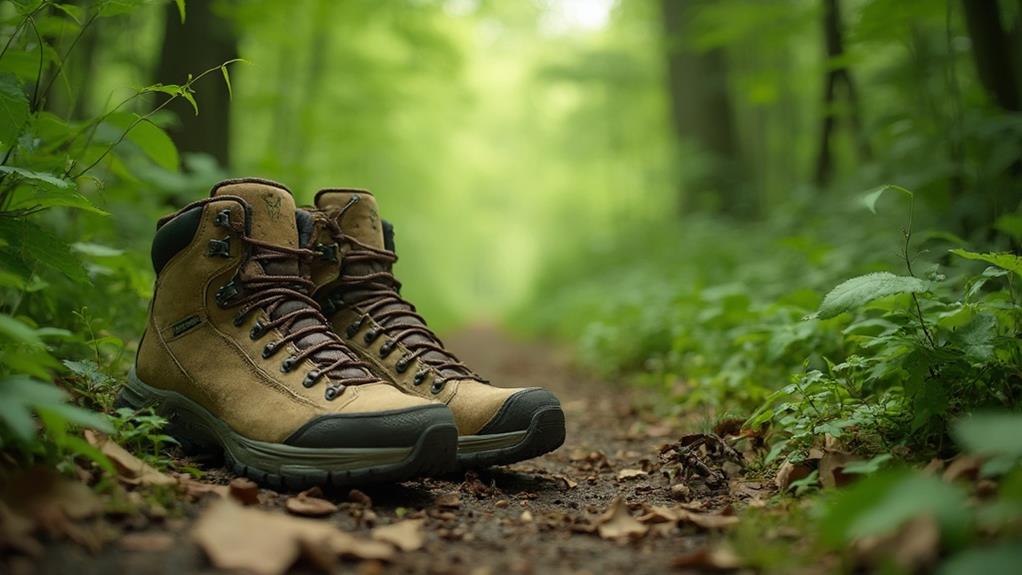
In the domain of hiking boot design, sustainability is increasingly prioritized through the utilization of eco-friendly materials such as recycled plastics and responsibly sourced leather, evidenced by certifications like the Leather Working Group and Bluesign.
These sustainable manufacturing practices not only reduce the environmental impact but also enhance the durability and longevity of the boots, thereby minimizing the need for frequent replacements.
Leading brands are further pioneering initiatives to offer repair services and detailed care instructions, ensuring that their products contribute to a more sustainable cycle of consumption in outdoor footwear.
Eco-Friendly Materials
A significant number of modern hiking boots are now crafted with eco-friendly materials, reflecting a growing commitment to sustainability in boot design. Brands have increasingly adopted the use of recycled materials—such as plastic bottles and discarded textiles—to curtail environmental impact and champion sustainability.
Additionally, the integration of biodegradable components in boot construction facilitates the reduction of landfill waste, contributing to a circular economy ethos within the footwear industry.
The Leather Working Group (LWG) certification plays a pivotal role in guaranteeing that leather used in hiking boots meets rigorous environmental standards, specifically in areas like water usage and chemical management. This commitment to responsible material sourcing is complemented by eco-conscious brands that prioritize the longevity and durability of their products, thereby reducing the need for frequent replacements.
Why Eco-Friendly Boots Matter
- Reduced Environmental Impact: By utilizing recycled and biodegradable materials, these boots lessen the strain on natural resources.
- Promote Sustainable Practices: Certifications and responsible sourcing guarantee high environmental standards.
- Encourage Long-Term Use: Durable designs lead to fewer replacements, minimizing waste.
In this evolving landscape, choosing eco-friendly hiking boots aligns with a broader commitment to environmental stewardship.
Sustainable Manufacturing Practices
Many innovations in hiking boot manufacturing are driven by the imperative to adopt sustainable practices that minimize environmental impact while maintaining high-quality standards. A focal point in this revolution is the integration of recyclable materials, such as repurposed plastic bottles and reclaimed footwear components.
These advancements not only reduce landfill waste but also support a circular economy within the industry. Brands demonstrating leadership in this arena often seek certifications from organizations such as the Leather Working Group and Bluesign, ensuring their materials meet stringent environmental and social responsibility criteria.
In addition to materials, eco-friendly tanning processes have become a cornerstone of sustainable boot design. By minimizing water consumption and reducing harmful chemical emissions, these processes notably curtail the environmental footprint of leather production.
Moreover, the adoption of modular designs facilitates easier repairs and component replacements, thereby prolonging the lifecycle of hiking boots and reducing waste.
A commitment to carbon neutrality is also evident among leading brands, which are optimizing their supply chains to include sustainable practices from raw material acquisition to final manufacturing.
This holistic approach underscores the evolving responsibility of boot manufacturers towards achieving sustainability without compromising performance or durability.
Cleaning and Maintenance Tips
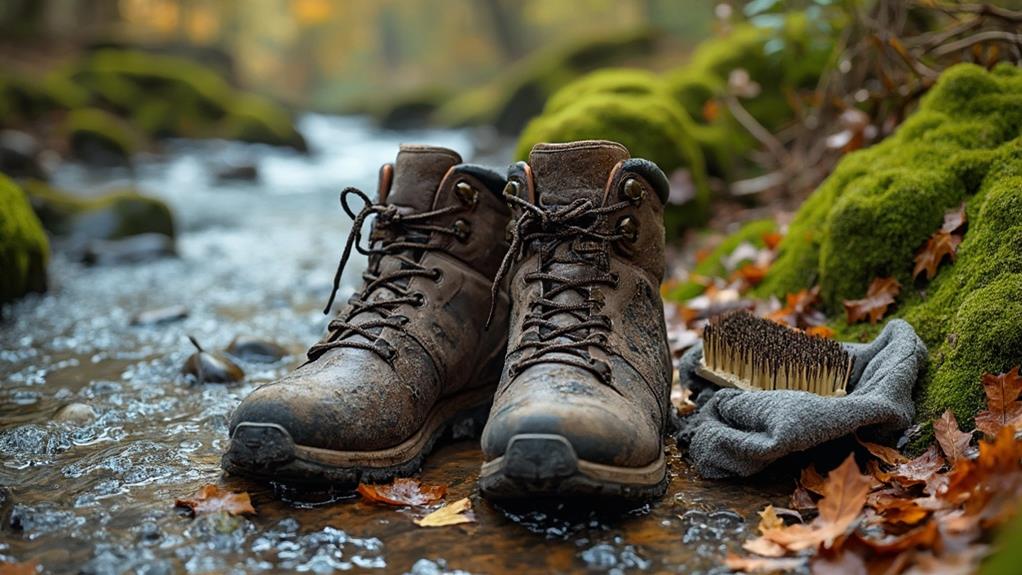
Regularly maintaining your hiking boots is vital to preserve their performance and longevity, especially when used for demanding activities like fell walking.
Proper boot care is essential to guarantee peak comfort and durability. Employing effective cleaning techniques can greatly enhance your boots' lifespan. After each excursion, thoroughly clean your boots using warm water and a stiff brush to remove mud and debris. This guarantees that the materials remain intact and functional.
Allow your boots to dry naturally at room temperature, steering clear of direct heat sources, which can compromise the integrity of waterproof membranes and leather.
To further extend the life of your boots, follow these steps:
- Condition and Protect: Treat leather boots with a suitable conditioner to maintain flexibility and prevent cracking. For synthetic boots, apply a spray-on waterproofing treatment.
- Insole and Lace Care: Remove insoles and laces for separate cleaning. Wash insoles with mild soap and water, and replace laces if they show signs of fraying.
- Proper Storage: Store your boots in a cool, dry place, away from sunlight. Utilize boot trees or stuff them with newspaper to maintain their shape during storage.
These meticulous practices not only preserve the boots' structural integrity but also guarantee peak performance on rugged terrains.
Expert Reviews and Recommendations
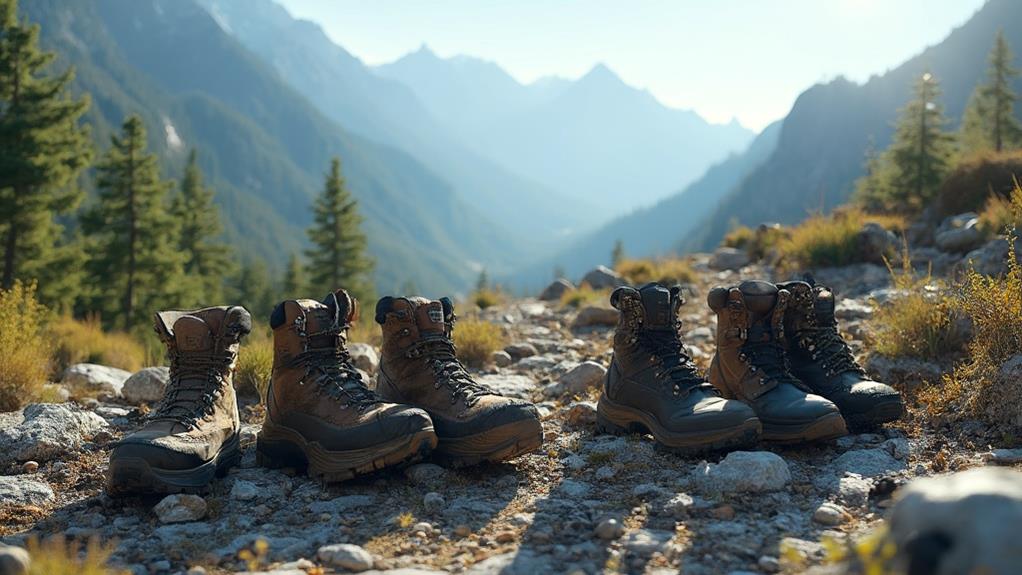
When commencing on the demanding activity of fell walking, selecting the right pair of hiking boots is essential for both performance and safety. Expert reviews highlight the Salomon Quest 4 GTX as a superior option, offering exceptional stability through its aggressive outsole, vital for maintaining traction on steep and rocky terrains.
This boot's design aligns with current hiking boot trends that prioritize rugged durability and precision control, retailing at approximately £220.
For enthusiasts focusing on long-distance fell walking techniques, the Hoka Kaha 2 GTX stands out with its superior cushioning and robust ankle support, weighing 1.15 kg per pair. Its construction is ideal for challenging conditions, ensuring comfort over prolonged periods.
Similarly, the Scarpa Rush Trk Pro GTX, with its oiled nubuck leather upper and ample ankle padding, is highly recommended for three-season usage, priced at £230.
For those seeking a balance of comfort and affordability, the Merrell Moab 3 Mid WP is lauded for its adaptable design, suitable for both novices and seasoned hikers, at a price point of £150.
Trends in Hiking Boot Technology
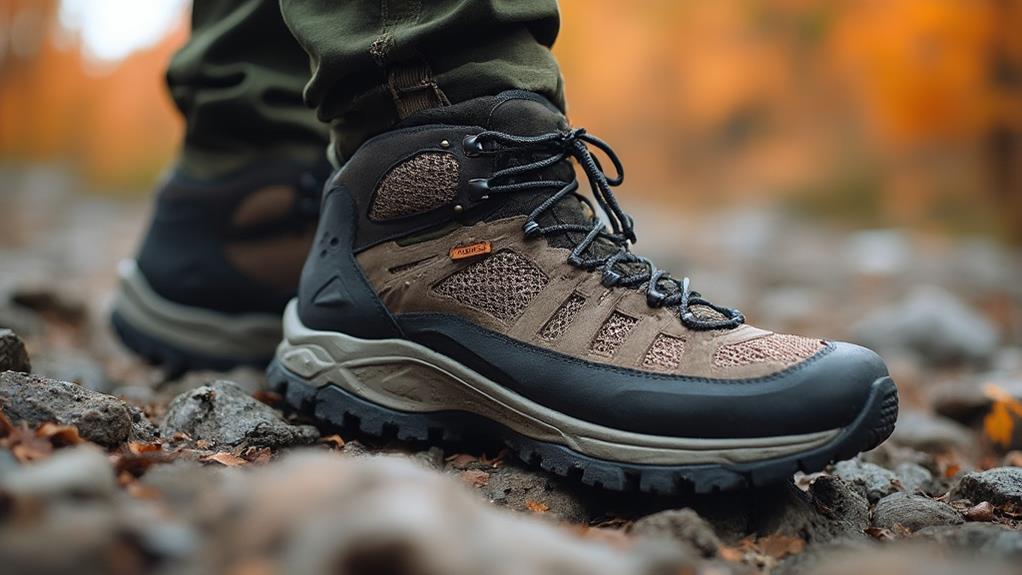
The evolution of hiking boot technology is marked by the integration of advanced materials and innovative design features that cater to both performance and environmental considerations.
Modern hiking boots now prominently incorporate lightweight synthetic fabrics and advanced Gore-Tex membranes, optimizing breathability and waterproofing while greatly reducing weight. This shift towards innovative materials is exemplified in models such as the Inov-8 RocFly G 390 GTX, which utilizes graphene technology in its outsoles, ensuring unmatched durability and traction on challenging, wet, and rocky terrains.
Performance enhancements are further realized through enhanced cushioning systems, as demonstrated by the Hoka Kaha 2. With thick EVA midsoles, these boots provide superior comfort, vital for minimizing fatigue during prolonged hikes.
Alongside, the trend towards customizable fit solutions is reshaping the industry, with adjustable lacing systems and multiple width options offering personalized fitment, enhancing both security and comfort for diverse foot shapes.
Furthermore, the industry's pivot towards sustainability addresses rising consumer demand for eco-friendly products. Many brands now emphasize eco-friendly materials and sustainable production practices, aligning technological advancements with environmental stewardship.
This convergence of innovation and responsibility creates a compelling narrative for the future of hiking footwear.
- Lightweight Innovation: Embrace the freedom of movement.
- Sustainable Practices: Walk with a lighter conscience.
- Customizable Fit: Experience personalized comfort.
Frequently Asked Questions
Are There Any Specific Brands That Cater to Vegan Hiking Boots?
When examining vegan materials for hiking boots, several brands stand out. Significantly, Xero Shoes, Merrell, and Vegetarian Shoes provide options. Conducting brand comparisons reveals varying durability and comfort levels, essential for ethically conscious consumers seeking sustainable footwear solutions.
What Are Common Signs That Hiking Boots Need Replacing?
Common indicators necessitating hiking boot replacement include significant boot sole wear, compromising traction, and loss of waterproof integrity, resulting in water penetration. Such deteriorations undermine performance and protection, necessitating prompt assessment for ideal outdoor safety and comfort.
How Can I Break in New Hiking Boots Quickly?
To expedite boot comfort and foot support, gradually wear new hiking boots indoors, increasing duration daily. Utilize specialized socks, adjust lacing techniques for ideal fit, and consider applying conditioning treatments to soften materials for enhanced adaptability.
Can Hiking Boots Double as Everyday Footwear?
Hiking boot versatility is contingent upon design and material. Brands emphasizing ergonomic support and cushioning may offer everyday comfort suitable for urban environments. However, specialized features for rugged terrain could compromise long-term suitability for daily wear.
What Socks Are Best Suited for Fell Walking With Hiking Boots?
For ideal performance in fell walking, select socks crafted from moisture-wicking materials like merino wool or synthetic blends. Prioritize insulation types that offer thermal regulation and cushioning, enhancing comfort and protection in variable terrains.
Conclusion
The thorough analysis of hiking boots for fell walking underscores the importance of selecting footwear that combines durability, comfort, and technological innovation. By evaluating features such as waterproofing, traction, and sustainability, informed choices can be made to enhance outdoor experiences. The exploration of top brands reveals advancements in design and material usage, catering to both men's and women's needs. Adherence to proper maintenance guarantees longevity, while staying abreast of technological trends supports peak performance in diverse terrains.